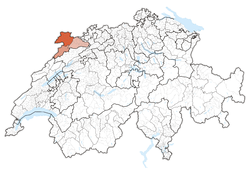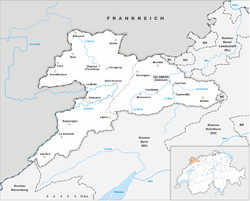Jura (canton)
| République et Canton du Jura | ||
|---|---|---|
| Canton of Switzerland | ||
|
||
 Location in Switzerland |
||
| Coordinates: 47°22′N 7°9′E / 47.367°N 7.150°ECoordinates: 47°22′N 7°9′E / 47.367°N 7.150°E | ||
| Capital | Delémont | |
| Subdivisions | 64 municipalities, 3 districts | |
| Government | ||
| • Executive | Gouvernement (5) | |
| • Legislative | Parlement (60) | |
| Area | ||
| • Total | 838.55 km2 (323.77 sq mi) | |
| Population (12/2015) | ||
| • Total | 72,782 | |
| • Density | 87/km2 (220/sq mi) | |
| ISO 3166 code | CH-JU | |
| Highest point | 1,302 m (4,272 ft): Mont Raimeux | |
| Lowest point | 364 m (1,194 ft): Allaine at Boncourt | |
| Joined | 1979 | |
| Languages | French | |
| Website | JU.ch | |
The Republic and Canton of the Jura (French: République et Canton du Jura), also known as the canton of Jura or canton Jura, is the newest (created in 1979) of the 26 Swiss cantons, located in the northwestern part of Switzerland. The capital is Delémont. It shares borders with the canton of Basel-Landschaft, the canton of Bern, the canton of Neuchatel, the canton of Solothurn and the French régions of Bourgogne-Franche-Comté and Grand Est.
The King of Burgundy donated much of the land that today makes up canton Jura to the Bishop of Basel in 999. The area was a sovereign state within the Holy Roman Empire for more than 800 years. After the Treaty of Westphalia in 1648 the Jura had close ties with the Swiss Confederation. At the Congress of Vienna (1815), the Jura region became part of the canton of Bern. This act caused dissention. The Jura was French-speaking and Roman Catholic, whereas the canton of Bern was mostly German-speaking and Protestant.
...
Wikipedia


